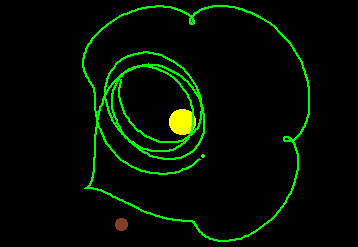
If Newton and Kepler could solve it for two bodies, why couldn't a generation solve it for three? We now understand that the kind of solution they were looking for cannot exist.

We see here the effects of increasing Jupiter's mass to 35000 (about a factor of 100 bigger than it was, still about a factor of 10 smaller than the sun.) Notice that the climate on the Earth is erratic. Change "View" to plot the Earth's trajectory (to speed things up). Notice that the Earth leaves the solar system after not so long... You can check this by "zooming" (right button) outside of the window. Clicking without moving restores the original window.
Clearly, no closed-form algebraic expression will give this path! If 100 Jupiters fry us in 100 years, how many years will it take one Jupiter to fry us?
Security from this kind of arithmetic only came in my lifetime. The year before I was born, Kolmogorov sketched some ideas about how one might show that our orbit was stable without solving for it! Arnold and Moser completed the proofs, and we now have the KAM theorem ...
 |
 |
|
James P. Sethna, sethna@lassp.cornell.edu.
![]() Statistical Mechanics: Entropy, Order Parameters, and Complexity,
now available at
Oxford University Press
(USA,
Europe).
Statistical Mechanics: Entropy, Order Parameters, and Complexity,
now available at
Oxford University Press
(USA,
Europe).